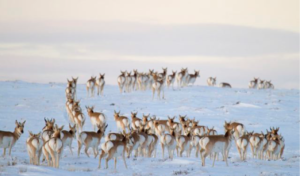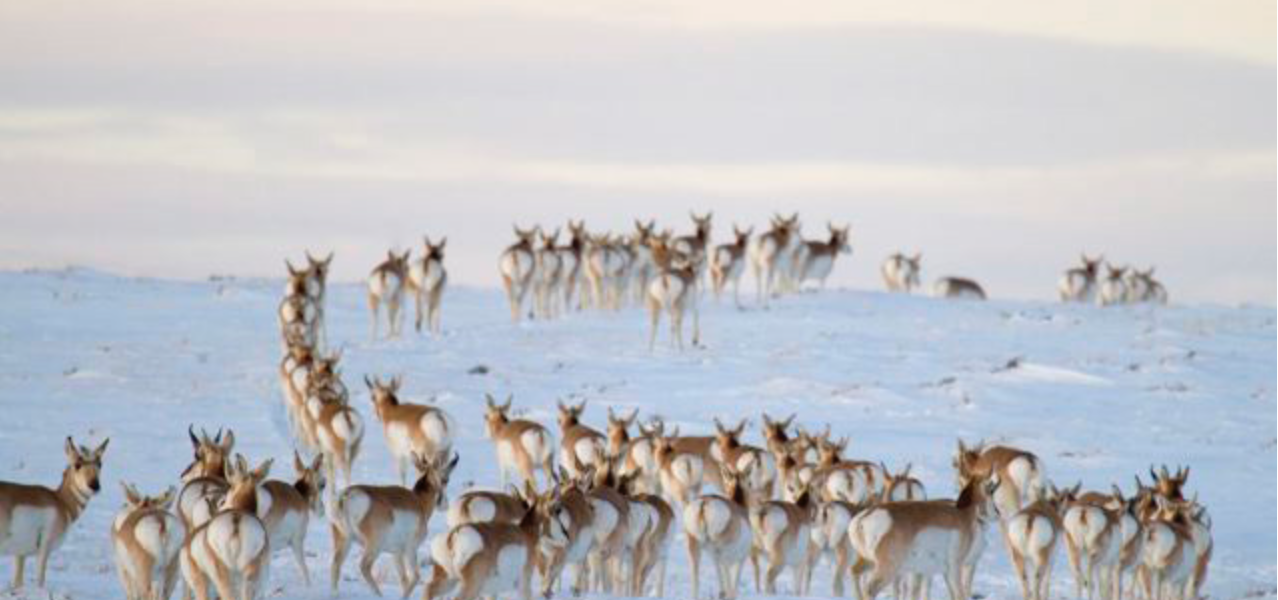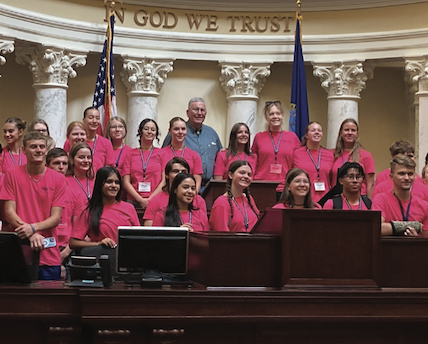By Mike Koshmrl
Jackson Hole News&Guide
Via- Wyoming News Exchange

JACKSON — Jackson Hole pronghorn’s critical winter range doubles as one of the largest natural gas fields in the U.S. But new research shows that the native tawny-and-white residents are avoiding, and even abandoning, the altered landscape.
That’s a conclusion emerging from an ecological examination of how hundreds of radio-collared pronghorn responded to the Pinedale Anticline field being built up and drilled over the past decade and a half. Findings showed that pronghorn both avoided wells by keeping their distance and abandoned the area entirely.
Those behavioral responses debunk a common presumption that the species adapts readily to gas field activity, putting pronghorn in a similar camp as their sagebrush-dwelling and development-averse counterparts: mule deer and sage grouse.
“There is a common perception that pronghorn are not affected by development, and that may be in large part because they are so mobile and move around so much,” Western Ecosystems Technology research biologist Hall Sawyer said. “I think what we showed with this work is that because of that mobility, it’s really difficult to detect behavioral changes or effects.”
“We were fortunate enough here to have 15 years of data from GPS collars,” he said, “and an opportunity to reveal that there are indeed behavioral effects.”
Those effects are laid out in a peer-reviewed article Sawyer authored that’s published in a recent edition of Conservation Science and Practice. Collaborators and co-authors include past and current Wildlife Conservation Society staffers Jon Beckmann, Renee Seidler and Joel Berger. That research team kept tabs on 29 pronghorn within the Anticline as far back as 1999 and 2000, before the vast sagebrush-covered plateau south of Pinedale was cut up by roads, pipelines and the gas pads where they end. The biologists stayed on it, tracking another 142 pronghorn by fitting them with GPS collars over a dozen years while the field was being developed.
“Between 2005 and 2017 pronghorn avoidance of wellpads increased by [a quarter mile] and their overall displacement from well pads increased by [a half-mile],” Sawyer wrote in the study. “Concurrently, the amount of time pronghorn spent in our [220-square-mile] study area declined by 22%, and the proportion of pronghorn leaving the study area increased by 57%.”
“Together,” he wrote, “these four independent metrics provide strong evidence that pronghorn response to energy development involves avoidance of infrastructure and partial abandonment of their traditional winter ranges.”
The Anticline, located about 60 miles southeast of Jackson, is the largest natural gas field in the Greater Yellowstone Ecosystem, and is authorized for up to 600 well pads accommodating up to 4,400 wells. It has been managed as crucial pronghorn winter range for more than a half century and has historically supported between 1,500 and 3,000 pronghorn, according to research from Sawyer. Migratory animals that traverse the “Path of the Pronghorn” leading to Jackson Hole are a subset of the pronghorn that winter amid and near the field. Those animals also are considered a part of the Sublette Pronghorn Herd.
Petroleum companies that operate in the Anticline include Ultra Resources, Pinedale Energy Partners and Jonah Energy, although much of the field’s assets have changed hands over the years.
Paul Ulrich, a spokesman for Jonah Energy, which only recently became a player in the Anticline, said he knows Sawyer and thinks he’s a “hell of a good researcher.” But Ulrich was unfamiliar with the Conservation Science and Practice paper and declined to comment on its conclusions.
Kevin Williams, a former operations manager for QEP Energy the News&Guide reached, also wanted to read the study before commenting.
Former Jackson Hole resident Berger, one of the co-authors, said that going into the fieldwork there was no hypothesis about how the Anticline would influence the resident pronghorn. Some wildlife species, he said, such as caribou, are able to habituate to industrial activity under some circumstances.
Looking back, Berger was disappointed with the response from gas producers as the data about impacts became clearer.
“It’s unfortunate that during the period when we worked with industry, industry always assured us that they wanted to find a way to maintain as many pronghorn on the landscape as there were when the development began,” Berger said.
“That clearly has not been the case,” he said, “as we watch the continual claims by industry that our findings are doubtful.”
A Wyoming Game and Fish Department biologist who oversees the Sublette Herd says he’s “not surprised” with Sawyer’s findings.
“We’ve seen that same response in other parts of this herd unit,” said Mark Zornes, the agency’s Green River regional wildlife coordinator. “We’ve seen where if they could avoid it, they did — we just didn’t have collar data to say that’s what was happening.”
A factor that could have fed the perception that pronghorn are less affected by energy infrastructure is that they do adapt, under some circumstances. As Zornes spoke Tuesday to the News&Guide, he was checking pronghorn hunters near a gas field south of the Anticline.
“I’m right now sitting on the edge of the south end of the Moxa Arch gas field,” Zornes said. “There’s a fair number of guys that come and check wells every day, and there are pronghorn standing all around me.”
But those animals are hemmed in by an impenetrable sheep fence, he said, and have nowhere else to go. When pronghorn have options other than sagebrush fields dotted by pads and crossed by roads, they take them.
“They’ll pass through gas fields pretty rapidly,” Zornes said.
As a whole, the Sublette Pronghorn Herd has recently hovered about 20% or so below its 48,000 objective. The population was estimated at 37,500 in the spring of 2018, which marks about a 50 percent decline from numbers in the early 2000s. The biggest determinant of how the herd is faring, Zornes said, has been winter severity and summer drought. It would be tough to say how much gas fields like the Anticline displacing animals has been a factor in the decline, he said.
“In relation to herd size, the Anticline is pretty darn small,” Zornes said. “Whether it’s having a population effect, I can’t tell you that.”
The Conservation Science and Practice study suggests there likely is a population impact.
“Certainly, severe winters contributed to population declines documented in the southern Greater Yellowstone Ecosystem by Wyoming Game and Fish Department,” the researchers wrote, “but our pronghorn avoidance and winter residency metrics did not appear to be driven by winter severity alone.”
For evidence they cited a consistent trend of more avoidance and displacement over time, regardless of winter severity over a study period that included two severe, seven average and six mild winters.
Sawyer’s paper says the impacts of lost habitat for pronghorn are of “particular concern” in Wyoming, because the Equality State is home to around half of the 800,000 pronghorn that occupy the planet. For perspective, nearly 2 million whitetail deer are estimated to live in the state of Wisconsin alone.
An important nuance to the research is that it took many years for the behavioral changes to make themselves clear. During the 15-year study both “avoidance and displacement” increased through time, almost as if the pronghorn were reverse habituating. During that period the Anticline became more and more built out, one possible explanation for the snowball effect over time.
Sawyer and Berger said more research is needed to pinpoint the mechanism explaining why pronghorns seemed to abandon the Anticline. That’s a trait that other Green River Basin species do not seem capable of, like mule deer, which instead stick it out within a gas field but avoid infrastructure, effectively shrinking their habitat. One reason could be that the pronghorn that fled the gas field ended up in better shape and went on to produce and rear more fawns. Another explanation could be that the pronghorn learned the behavior, and being a mobile species they simply took off.
“We do know that some pronghorns show fidelity to traditional migration routes and winter-use areas,” Berger said, “and when these patterns of memory become fractured the long-term consequences cannot be good for the species for which many citizens in the state care deeply about.”
Gas drilling in the Green River Basin has continued at a fast clip in critical pronghorn habitat. Bureau of Land Management officials told the News&Guide in 2017 that the Pinedale Field Office was the busiest BLM office in the nation for drilling applications.
Much of that has been infill drilling within existing fields, like the Anticline, but another component are new fields that have been authorized and are being drilled out.
One of those fields is Jonah Energy’s Normally Pressured Lance project, south of the Anticline and Jonah fields, which would add up to 3,500 wells on 220 square miles. It intersects the southern reaches of an undesignated but well-documented migration route that’s used by the Sublette Pronghorn Herd, and especially by animals that summer in Jackson Hole.
Jonah Energy’s Ulrich said he “absolutely” plans to review Sawyer’s research and plans to heed the science.
“You can bet we’re going to take a hard look at that,” Ulrich said, and “do exactly what we’ve done from day one, which is follow the science.”







